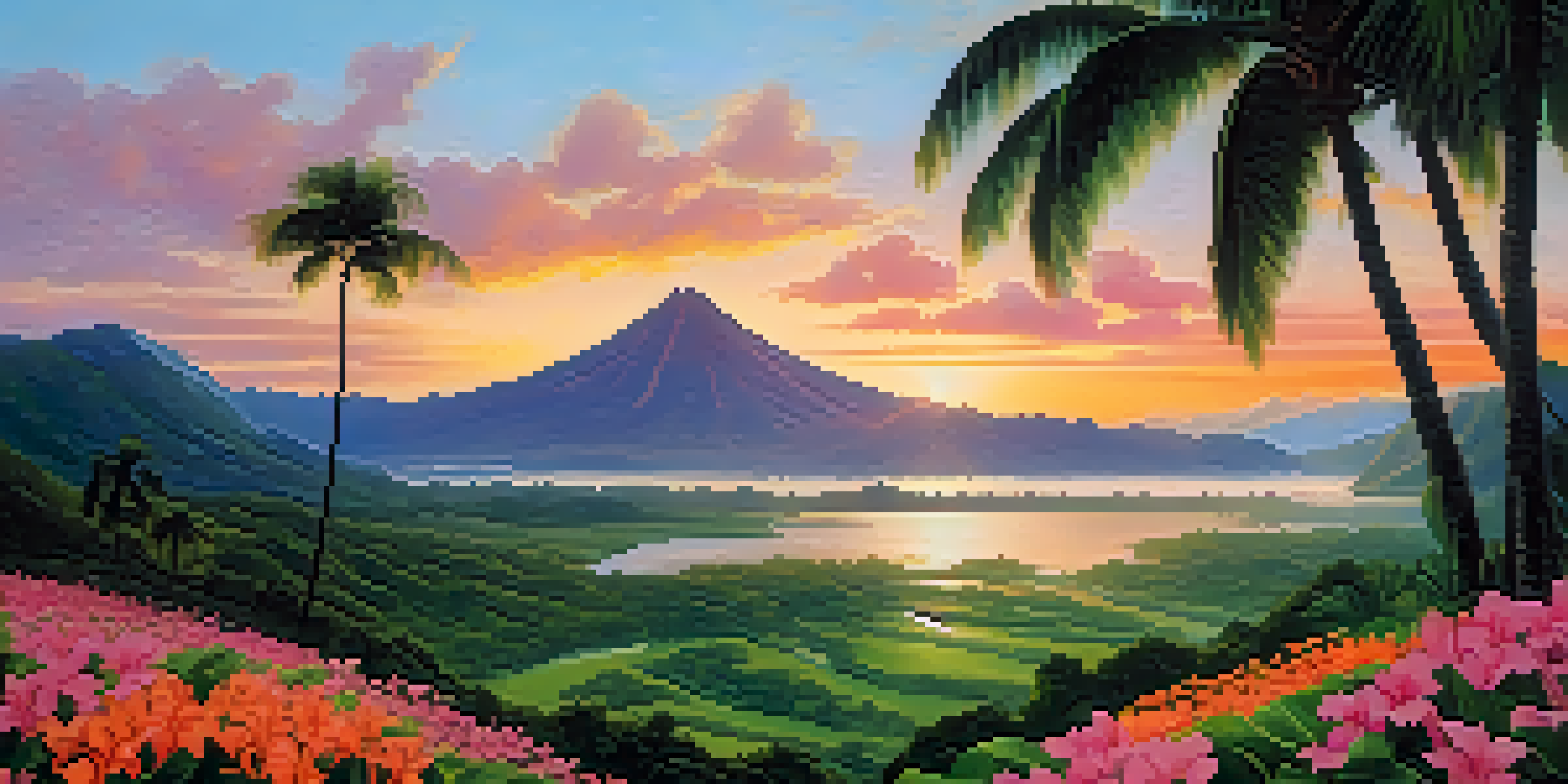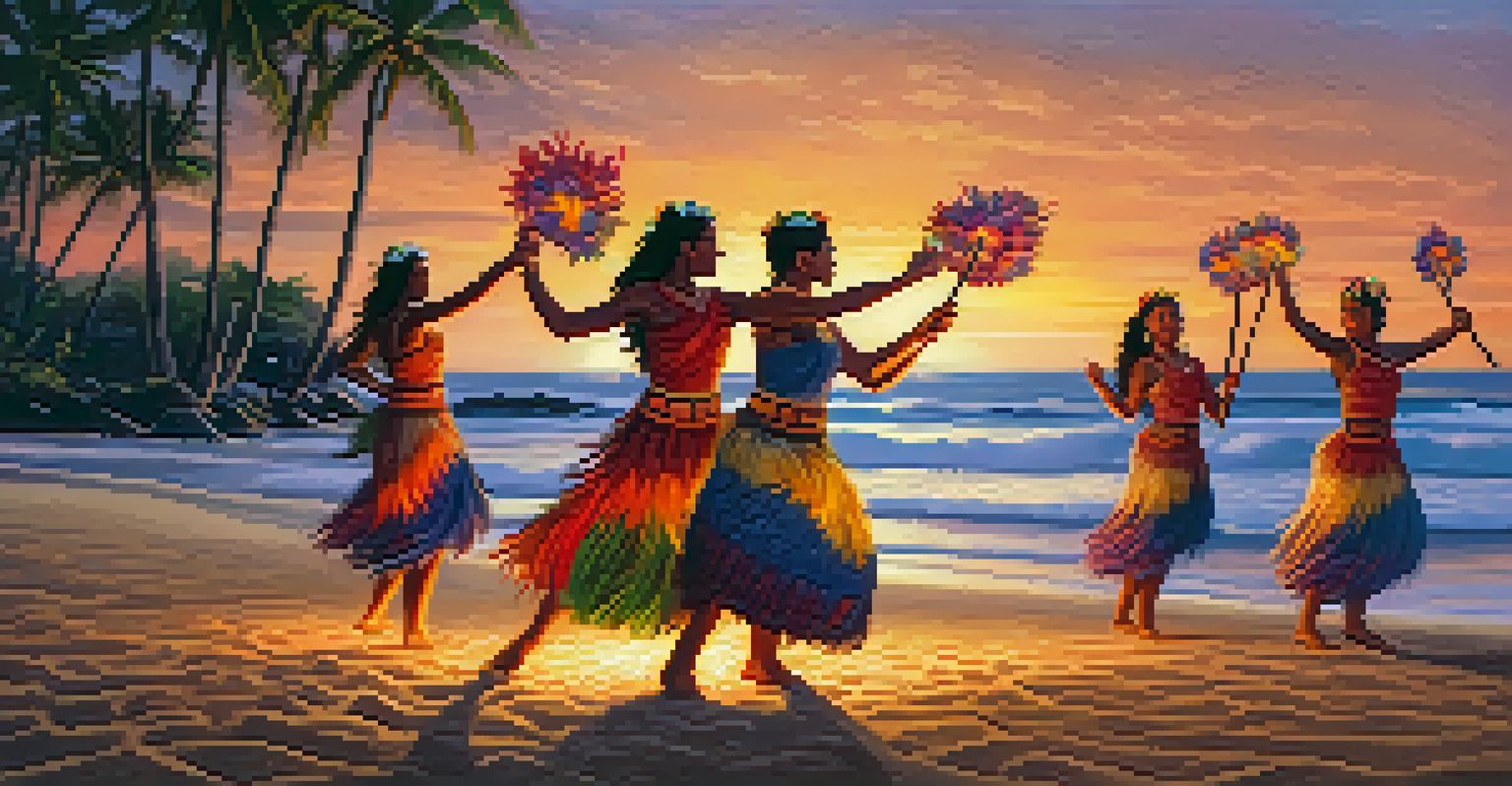The Origins of Hawaiian Mythology: A Cultural Overview

Understanding the Roots of Hawaiian Mythology
Hawaiian mythology is a vibrant tapestry woven from the rich cultural history of the islands. It encompasses stories, deities, and beliefs that have been passed down through generations, reflecting the values and experiences of the Hawaiian people. At its core, mythology served not only as entertainment but also as a means of understanding the natural world and human existence.
The stories we tell are a reflection of who we are and where we come from.
These stories often feature gods and goddesses, like Pele, the goddess of fire and volcanoes, illustrating the deep connection Hawaiians have with nature. Each tale carries lessons about respect, balance, and the interconnectedness of life, resonating with the community's values. This mythology is not static; it evolves, adapting to the changing cultural landscape while maintaining its essence.
Understanding these origins is crucial for grasping how they influence contemporary Hawaiian culture. Today, many of these myths continue to inspire art, dance, and even modern storytelling, showcasing the enduring legacy of Hawaiian traditions.
The Role of Oral Tradition in Mythology
Oral tradition plays a pivotal role in the transmission of Hawaiian mythology. Before the advent of written language, stories were shared through chants, songs, and performances, allowing them to flourish within the community. This method of storytelling not only preserved the myths but also fostered a sense of identity among the people.

Each storyteller added their unique flair, ensuring that the tales remained dynamic and engaging. This practice highlights the communal aspect of mythology, where everyone contributed to the collective narrative. As such, oral tradition became a way to reinforce cultural values and community bonds.
Hawaiian Myths Reflect Cultural Values
Hawaiian mythology serves as a vibrant reflection of the values, experiences, and interconnectedness of the Hawaiian people with nature.
Today, many Hawaiians continue to honor this oral tradition, ensuring that the rich tapestry of their mythology remains alive. Events like hula performances and storytelling festivals serve as platforms for sharing these ancient tales, connecting generations and promoting cultural pride.
Key Deities in Hawaiian Mythology
Central to Hawaiian mythology are its deities, each representing different aspects of nature and human experience. For example, Kane is the god of creation and fresh water, symbolizing life and growth, while Kanaloa represents the ocean and the underworld. These gods and goddesses embody the Hawaiian worldview, where nature and spirituality are intertwined.
Mythology is the womb of a culture, its stories nurturing the values and beliefs that shape our identity.
The stories surrounding these deities often convey moral lessons and cultural values, teaching respect for the land and its resources. For instance, the tale of Pele and her rivalry with her sister Hi'iaka emphasizes the importance of balance and harmony in nature. Such narratives continue to resonate, reminding Hawaiians of their responsibilities to their environment.
Understanding these deities provides insight into the Hawaiian perspective on life. They serve as reminders of the deep respect Hawaiians hold for their surroundings and the belief that everything is interconnected.
Mythological Stories and Their Meanings
The stories of Hawaiian mythology are rich with symbolism and meaning, often reflecting the struggles and triumphs of the Hawaiian people. For instance, the story of Maui, a demigod known for his cleverness, showcases his attempts to benefit humanity, such as fishing up the islands and slowing down the sun. These narratives not only entertain but also offer lessons about resilience and ingenuity.
Many myths address the themes of love, conflict, and harmony, providing a framework for understanding human emotions and relationships. The story of Laka, the goddess of hula, highlights the importance of dance as a form of expression and connection to the divine. This illustrates how mythology serves as a bridge between the spiritual and the physical realms.
Oral Tradition Preserves Myths
The oral tradition is crucial for passing down Hawaiian mythology, fostering community identity and ensuring the stories remain dynamic and engaging.
Moreover, these stories are often retold in various forms, allowing them to adapt while retaining their core messages. This adaptability ensures that the lessons of Hawaiian mythology remain relevant even in modern contexts.
The Influence of Geography on Mythology
The unique geography of Hawaii has significantly shaped its mythology, with each island featuring its own distinct stories and deities. For example, the volcanic landscapes of the Big Island are intrinsically linked to the stories of Pele, while the lush forests of Kauai are associated with the goddess Hi'iaka. This geographical diversity fosters a rich variety of myths that reflect the specific characteristics of each island.
Hawaiian myths often emphasize the relationship between people and their environment, illustrating how geography influences cultural practices and beliefs. The stories serve as a reminder of the land's power and beauty, encouraging respect and stewardship. This connection to the land is deeply ingrained in Hawaiian identity, making the myths relevant to daily life.
As Hawaiians navigate contemporary challenges, these geographical influences and associated myths continue to guide them. They serve as a source of inspiration, helping communities maintain their cultural identity amidst modernity.
Modern Interpretations of Hawaiian Myths
In recent years, there has been a resurgence of interest in Hawaiian mythology, with modern interpretations bringing these ancient tales to new audiences. Artists, writers, and filmmakers draw inspiration from traditional myths, reimagining them to resonate with contemporary themes and issues. This fusion of old and new helps keep the mythology alive and relevant.
For example, graphic novels and films have explored the stories of Hawaiian deities, presenting them in a format that appeals to younger generations. These adaptations often highlight the core messages of the myths while making them more accessible. Such creative endeavors not only entertain but also educate audiences about the richness of Hawaiian culture.
Modern Adaptations Keep Myths Alive
Contemporary interpretations of Hawaiian myths, through various media, help to educate new audiences and maintain cultural relevance.
This modern revival of mythology fosters a sense of pride and connection among Hawaiians, encouraging them to explore their roots. As these stories gain visibility, they contribute to a broader appreciation of Hawaiian culture in a global context.
Preserving Hawaiian Mythology for Future Generations
Preserving Hawaiian mythology is essential for maintaining the cultural heritage of the islands. Efforts to document and share these stories are crucial, especially as younger generations become more disconnected from traditional practices. By recording oral traditions and promoting cultural education, Hawaiians can ensure that their rich mythology continues to thrive.
Organizations and community groups play a vital role in this preservation process. They host workshops, storytelling events, and cultural festivals that celebrate Hawaiian myths and traditions, encouraging active participation from the community. This engagement fosters a sense of belonging and pride, reinforcing the importance of cultural heritage.

As the world becomes more interconnected, it is vital for Hawaiians to share their mythology with a broader audience. By doing so, they not only honor their ancestors but also enrich the global cultural landscape, ensuring that the beauty and wisdom of Hawaiian mythology endure.